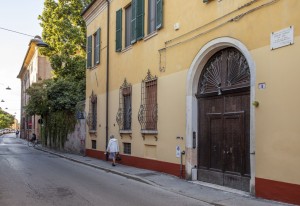Via Scandiana
Road in the old town of Ferrara that goes from the intersection with Via Madama/Via Borgovado (where it becomes Via Borgo di Sotto) to the intersection with Via Formignana/Via Carlo Caneva.
Name and brief history
Even if its current name doesn’t hint at it (unlike the original name) the most famous delizia built by the Este family is located on this road: Palazzo Schifanoia As Girolamo Melchiorri noted, «at Palazzo Schifanoia princes of the House of Este were born; here they celebrated marriages, holidays, banquets and danced; it was here that ambassadors, princes, cardinals and bishops slept» (G. Melchiorri, Nomenclatura ed Etimologia delle Piazze e delle Strade di Ferrara e Ampliamenti all’Opera di Gerolamo Melchiorri, edited by C. Bassi, 2G Editrice, Ferrara 2009, p. 140). Currently a museum, it can be visited at no. 23 Via Scandiana. Another defining element of this road is the north side of the Basilica of Santa Maria in Vado, restored in 2000, and just a little further on, the suppressed Church of San Vito, the annex of a former Augustinian Monastery built in 1256. It was suppressed in 1909 and then turned into military barracks.
Nella letteratura
Giorgio Bassani seems to have located the house of his fictional alter ego and protagonist of ‘Behind the Door’, Bruno Lattes, in this street. In fact, Via Scandiana runs parallel to Via Cisterna del Follo, the street where the writer’s house really was (at no. 1), sharing some commonalities with the residence of Bruno Lattes. The scene that reveals the location of the house is, however, a bit vague: the protagonist is walking, the writer lingers on Via Scandiana and immediately Bruno Lattes rings the bell. The proximity of Via Scandiana and Via Cisterna del Follo is such that the protagonist could have walked from one to the other. Yet, the text of the novel never makes it entirely clear, and the attribution of the address is simply a hypothesis.
Quotes
“We had almost arrived. We left Via Madama by Piazza Santa Maria in Vado and turned down Via Scandiana. ‘What was that kind of barrier down there at the end of the street?’ Pulga asked me as he kept on walking, and at the same time pointed towards the mist-covered prow of the Montagnone, at which it seemed Via Scandiana came to a halt. I stopped in front of the entrance to my house, pressed the bell, and turned round to explain to him what the Montagnone was. But he was already distracted by something else. ‘Good heavens!’ he exclaimed in a serious tone. ‘It’s a mansion!’ He stepped back to the centre of the street, keeping his gaze upwards. ‘Is it all yours?’ ‘Yes.’ ‘It must have heaps of rooms.’ ‘Quite a few...Including the first and second floor, there must be something like fifty.’ ‘And they’re all taken just by your family?’ ‘Oh no. ‘We live only in those on the second floor. There are tenants on the first floor.’ ‘So, you and your family live in twenty or so rooms?’ ‘More or less.’ ‘How many of you are there?’ ‘There are five of us. My father, my mother and us three children: that is me, my brother, Ernesto, and my sister, Fanny. Then you’d have to count the maids... ‘Twenty rooms! Imagine the cost to heat them. And the tenants?’ At that moment, the latch of the door sprang open. I raised my eyes. My mother was at the window.” (Giorgio Bassani, ‘Behind the Door’, in The Novel of Ferrara, Translated by Jamie McKendrick, Penguin Classics, 2018, e-book location 7830-7839) ‘As a child, when my mother with Ernesto in her arms (Fanny had not yet been born) took me out on Montagnone, and sat down on the grass on the vast square in front of Via Scandiniana, from the top of which one could just barely make out our house’s roof from among the sea of roofs around the big jetty of the church of Santa Maria in Vado, it was with considerable fear, I remember, that I went to lean on the parapet that skirted the square on the side nearest the country, and looked down over a drop of some thirty metres.’ (G. Bassani, ‘The Garden of the Finzi-Continis’, in The Novel of Ferrara, Translated by Jamie McKendrick, Penguin Classics, e-book location 4524) ‘The stretch that goes from Via Madama to Via Campo Sabbionari (which, skirting the Basilica of Santa Maria del Vado, marks an opening without houses) was once called ‘Piazza di Schivanoia’; and the stretch that goes from Campo Sabbionario to the aforementioned ramparts was called Via di Formignana. They were called Piazza and Via di Schivanoia or Schifanoia after the Este palace of that name... The road was then named Strada di Via Scandiana because Palazzo Schifanoia, when owned by Marfisa d’Este, was leased to Giulio Thiene, Count of Scandiano, who lived there from 1582 to 1590; that short stay was enough to change, with true lightness, the historic Via di Schifanoia name... (G. Melchiorri, Nomenclatura ed Etimologia delle Piazze e delle Strade di Ferrara e Ampliamenti all’Opera di Gerolamo Melchiorri, edited by C. Bassi, 2G Editrice, Ferrara 2009, p. 139s)
Bibliography
- Luciano Chiappini, Gli Estensi. Mille anni di storia, Corbo, Ferrara 2001
- Bassani, Giorgio, Il giardino dei Finzi Contini, Mondadori, Milano 2001
- Giorgio Bassani, Dietro la porta in Opere, Il romanzo di Ferrara, Mondadori 2001
- Melchiorri, Gerolamo, Bassi, Carlo, Nomenclatura ed etimologia delle piazze e strade di Ferrara. Ampliamenti all'opera di Gerolamo Melchiorri, 2G, Ferrara 2009
Compiling entity
- Assessorato alla Cultura e al Turismo, Comune di Ferrara
Author
- Barbara Pizzo

